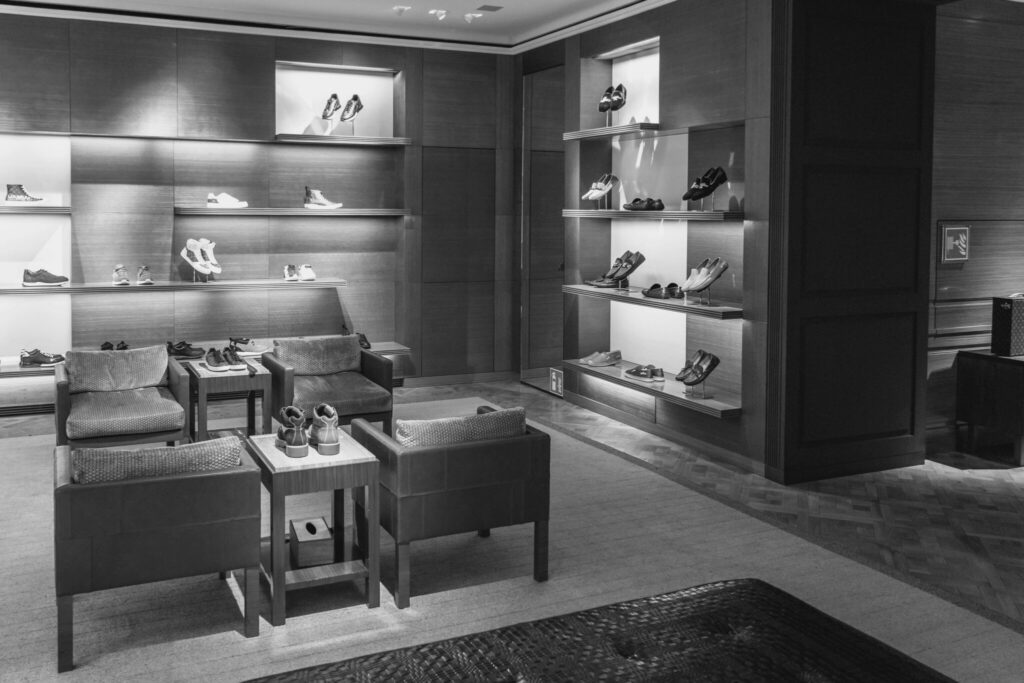What is point-of-sale atmosphere? Explained by Philip Kotler in 1973 :
This is the environment in which a product is purchased at a point of sale. It includes architecture, ergonomics, lighting, colors, temperature, noise, musical and/or olfactory ambience, assortment and layout, orientation and signage, animations, etc., all of which are direct or indirect stimuli for generating traffic at the point of sale, attracting customers' attention, influencing their attitude and/or triggering purchasing behavior.
The atmosphere of a physical point of sale is made up of 3 dimensions:
- Ambient factor
- Design factor
- Social factor
In the current context, with the emergence of new technologies in the point-of-sale shopping experience, new factors are emerging.
What variables make up the atmosphere of a luxury outlet?
Atmosphere
- Visual ambience: attracting the eye
Lighting, decoration and visual merchandising, it's essential to dazzle the visitor's eyes. Lighting creates the right atmosphere for every situation. Soft lighting in an intimate setting can create a feeling of comfort, for example. Works of art or decoration can add a visual identity to the point of sale.
- Soundscape: listening to the environment
The choice of music and soundscape must be adapted to the context or story being told. Music, sound or the absence of sound can create a very specific atmosphere.
- Tactile ambience: playing with materials
Touching, testing, trying out - the variety of textures and materials that make up décor is also important during the consumer's journey.
- Olfactory ambience: using your sense of smell
Whether subtle, discreet or very present, the chosen fragrance enhances the in-store experience and can become a veritable olfactory signature for the point of sale.
- Culinary/gustatory ambience: bringing taste to the table
Taste remains a cognitive bias, just like the other senses, in a 360° sensory experience. Customer satisfaction is enhanced by the possibility of drinking or tasting throughout the entire experience. This gesture can also be perceived as a gift that enhances the customer experience.

Design
- Design and scenography: making products spectacular
In addition to visual merchandising, scenography plays an important role in presenting the product in a unique setting or universe. The selection of materials, the architecture, the layout, both inside and out, the design of the point of sale must reflect the codes and values of the company and provide an identifiable visual identity.
- Customer paths and zoning: telling a story
When entering a luxury boutique, the customer should be invited to discover a story where each room invites him into a new universe. Dividing the store into different zones or sections can help create a targeted itinerary. Each zone corresponds to a product category (shoes, leather goods, cosmetics, etc.) or a theme (a season, a collection, a color). It's important that each area immerses the customer in its own universe.
- Comfort: creating a relaxation area
Providing relaxation areas is essential to enhancing the customer experience in luxury boutiques. Providing suitable furniture for relaxation (armchairs and sofas...), offering refreshments or snacks, proposing areas dedicated to fitting... In order to stimulate their purchasing decision, customers need to benefit from a comfortable and pleasant experience.
Social
- Sociability: inviting customers to talk
In a retail outlet, and especially in a luxury atmosphere, human contact is essential. Customers must be welcomed, given the right information and the right services at the right time. Sales staff must be available, helpful and welcoming.
Consumers want to be immersed and co-create their experience at the point of sale: they want to interact with the product. The "triability" factor is a key dimension.
Possibility of trial
- Try: Invite to discover
Customers must have the opportunity to try, touch and interact with the product, at different times and in different ways. Welcome the customer in a private space, or provide them with a tailor-made, exclusive experience. Technological tools can make fitting easier, with augmented-reality mirrors, connected booths or diagnostic tools.
The point of sale is increasingly integrating digital tools throughout the purchasing process to enhance the in-store customer experience. The technological factor is an inescapable dimension of a luxury outlet.
Technology
- Phygitalization: integrating digital tools at the point of sale
There are as many ways to digitalize a point of sale (digital screens, QR codes, applications or tablets) as there are situations. The aim of digitalization is above all to create new experiences and offer new possibilities for interaction: product personalization, virtual fitting, interactive games... there are many different contexts.
The atmosphere of a luxury outlet is distinguished by its exceptional environment. It embodies the brand's universe, offering a unique, personalized and memorable shopping experience, in line with the expectations and desires of luxury customers. It integrates various key factors: ambience, design, social andtriability, harmoniously integrating digital tools to enrich the shopping experience and communication throughout the entire experience. The result is an immersive, emotional experience, inviting customers to interact with the product and immerse themselves in the brand's universe.


